One of the most common complaints people have about their guns, particularly as they get into their 40’s and beyond, is that they can’t “pick up” their gun sights as well as they used to. This is usually the opening salvo that ends with, “Can I buy something to fix this problem?”
Unfortunately it’s more complicated than just plopping the charge card on the gun store counter. Whether or not the problem has a solution — and what that solution might be — depends on the individual and to what use the gun is being put.

The Root Of The Problem
Here’s something you probably know even if you don’t want it to be true: we’re all getting older, which means our body parts are getting older too. I don’t like it any more than you do, but it’s a fact of life! We can get plastic surgery and hair transplants to give us the outward appearance of youth, but mechanisms like our eyes can’t be as easily overhauled. As we age it becomes increasingly difficult for our eyes to rapidly change focus, to focus on objects that are close to us, or to differentiate between colors.
Our eyes focus on objects by changing the shape — the curvature — of the cornea and the lens that sits behind it. This process is called accommodation, and as the years pass, our corneas and lenses become less elastic and less able to change shape. This condition is called presbyopia, which is defined as the loss of accommodation. It starts to occur around age 40 and means that our eyes can’t deform as much as they used to, which in turn means their minimum focus distance becomes farther and farther away.

Even if we can still focus closely, it takes more time to do so. That’s because our eyes don’t change shape as quickly. When we’re young, our eyes can change their focus point very rapidly, but they slow down over time. It takes longer for our eyes to get to any given focus point, and eventually they don’t get there at all. Diabetes, high blood pressure, and smoking aggravate this degenerative process.
That’s not the only problem. The muscles that open and close our pupils also age, making reactions to changing light conditions slower and less precise. While that’s happening, the cells in our retinas lose some sensitivity, causing colors to appear dull and reducing the contrast between different colors and brightness levels.
I don’t know about you, but I could live with all of this except for one tiny detail: it makes shooting harder!
How Does This Affect Shooting?
This normal degeneration of our eyesight certainly makes recreational shooting less enjoyable, but can make defensive shooting less reliable. The former is an annoyance, but the latter is a serious problem.
In those cases where we need to use our gun sights (remember that not all shooting problems require that we do), the standard procedure has always been to focus on the front blade and let the rear sight and the target blur. As presbyopia sets in, the ability to rapidly shift focus from the target to the sights is reduced, and sooner or later the minimum focus distance exceeds the length of our outstretched arms. This means that the front sight is always blurred and it’s not possible to focus on it without glasses.
Focus problems can happen in conjunction with, or separately from, a reduction in contrast and color perception. This makes the sights harder to distinguish from the target or from each other (front to rear).
A person with normal eyesight finds it’s generally easy to tell that the sights are darker or lighter or a different color than the target at which they’re aimed, and that the front sight is separate and distinct from the rear. As contrast and color perception decline, it becomes harder to separate where the sights end and the target begins. Even if the shooter can focus on the front sight, it’s hard to tell where the sights are actually pointed!
Combine a loss of accommodation with a reduction in contrast and it can be nearly impossible to see and align the front sight, rear sight, and target. In other words, for those times when we need to use our sights, we’re not able to do so!
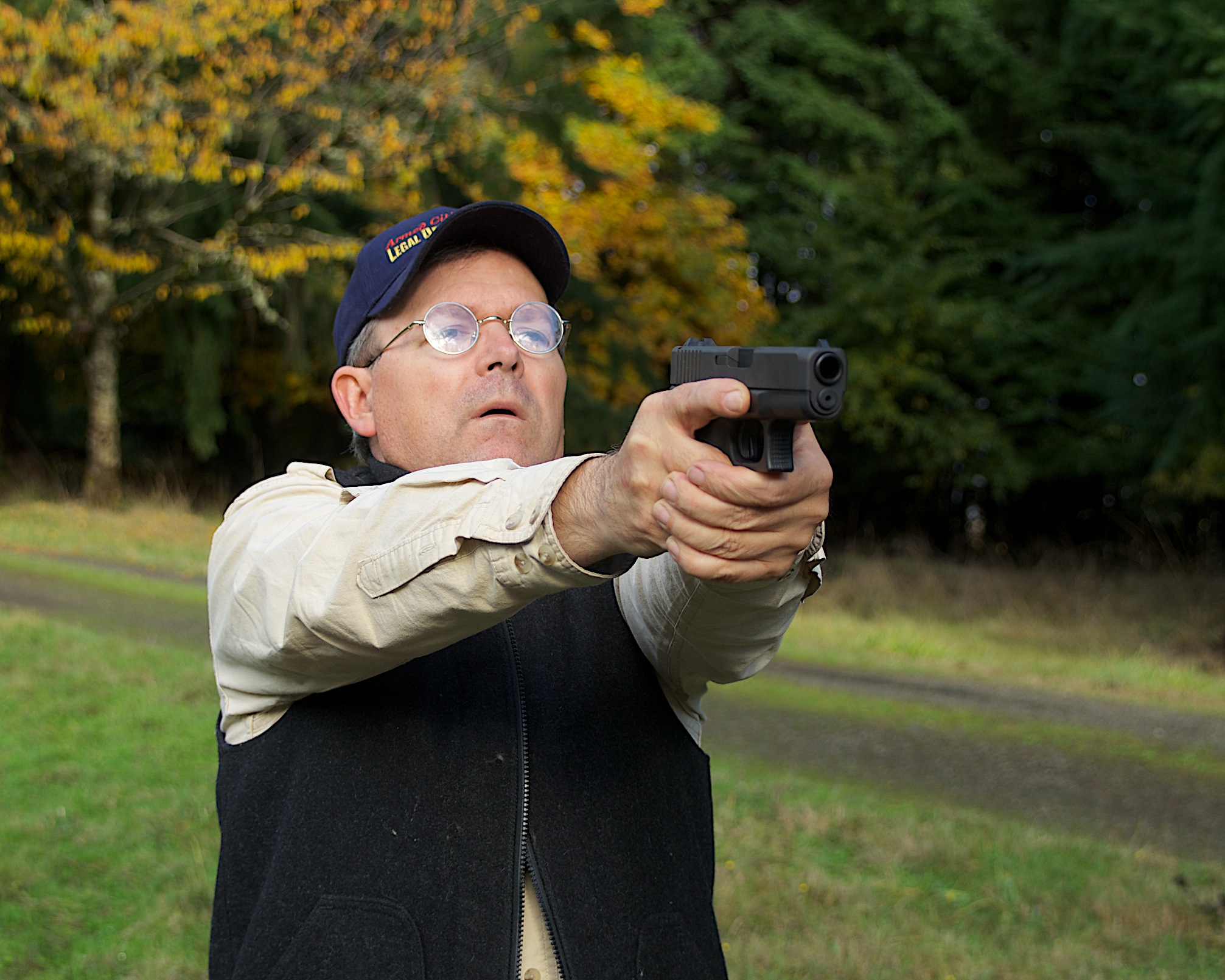
Trying to look through bifocals results in a leaned-back, unstable stance that gives far less control over the gun.
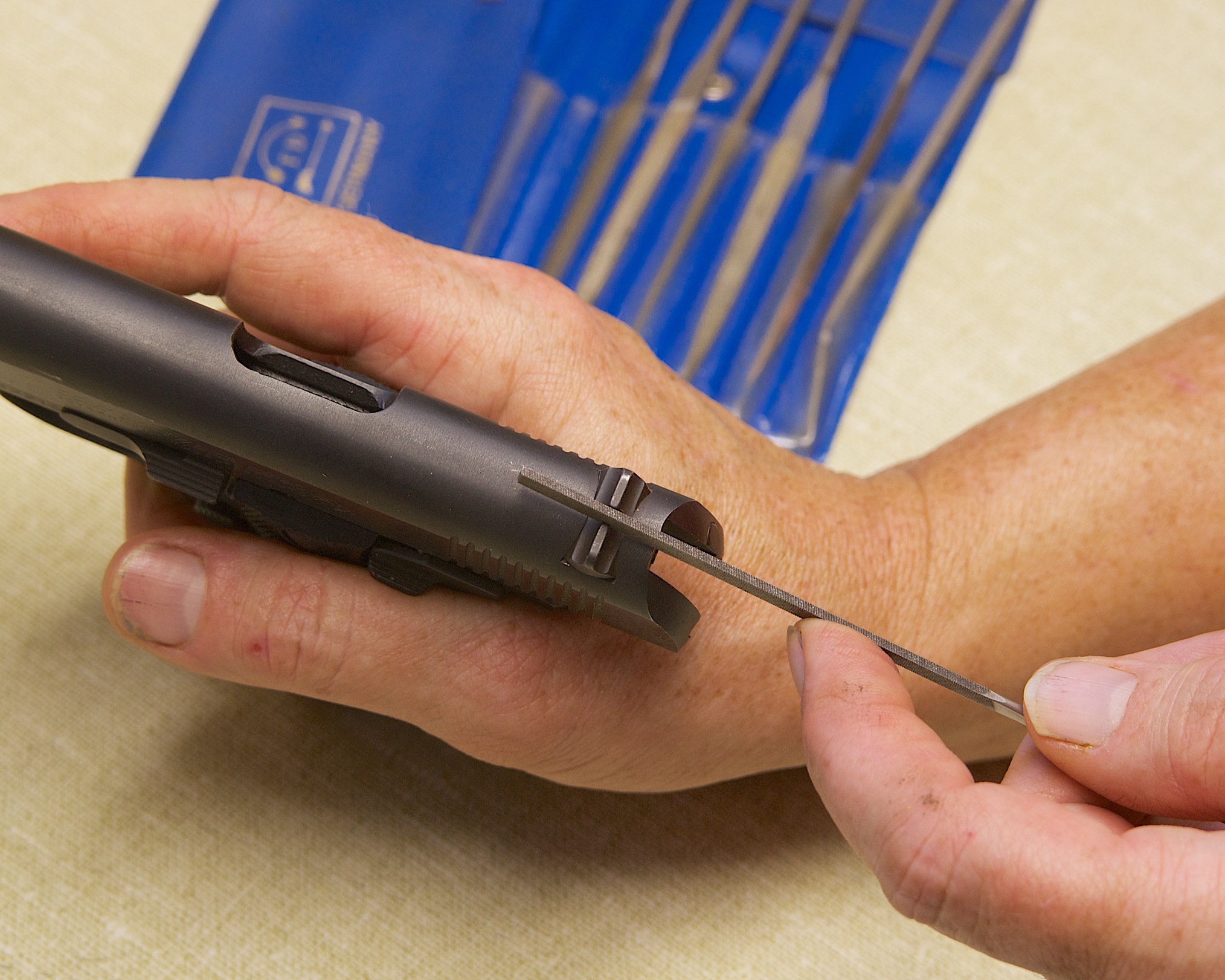
Carefully filing out a too-narrow rear notch often dramatically improves contrast between the front and rear sights. Use a fine jeweler’s needle file and go slowly.
Some Hardware Solutions
When someone says, “I’m having trouble picking up my sights,” it’s important to know exactly what he means. Is he having a problem getting the front sight in focus, or is the problem that he can’t differentiate the sights from each other or from the target? The answer will determine if there is a hardware solution.
If the sights are out of focus, it’s possible to simply wear prescription glasses cut for that distance (reading glasses). That works fine on a nice, calm range — but in a defensive encounter, there may not be time to put the special glasses on, or they might get knocked off during the fight. This leaves the shooter right back where he started, and perhaps in worse condition!

Wearing bifocals is a fact of life for many of us with vision issues. The problem with bifocals is that they force the shooter to tip the head back, which in turn forces him to stand up straight. Not only is that posture not congruent with what human beings do in a fight, it’s also impossible to maintain any sort of multiple-shot recoil control.
Some shooters have bifocals ground at the top of their lenses so that they look through the bifocal when in a good defensive shooting stance. This solution has the same drawbacks as the separate reading glasses, and is more expensive to boot!
Other than specially made glasses, there’s not a whole lot that can be done about a focus problem. Some people buy larger sights (“Big Dot” and “Express” sights are common examples), hoping that the bigger the sight, the easier it will be to focus. That really doesn’t work; the focus problem is a matter of distance, not size. Installing a bigger front sight just means that the out-of-focus blob will be bigger — not sharper!
The issue of insufficient contrast, however, does benefit from sight change or modification. The easiest solution is to paint the front sight a different color than the rear — preferably a very bright color. This increases the contrast between the two and makes it much easier to separate them when in the field of vision.
The bright color also makes differentiating the sights from the target, as very few targets are fluorescent orange or green. There are kits available containing several colors of bright, tough paint designed specifically for sight applications.
A variation on the painting trick is to have a plastic insert milled into the front blade. This was the primary factory configuration on many S&W, Colt and Ruger guns up through the turn of the century, though much less common now. A gunsmith can easily install such an insert on any ramped front blade.
Sometimes slightly widening the rear notch by itself is enough to increase the contrast between the blades. This can be done by a gunsmith using a mill, or at home using a fine-tooth Swiss pattern file. Great care must be taken to remove exactly the same amount of material from both sides of the notch, or the windage of the gun will be affected.
One time-honored way to make the sights easier to differentiate is to have a gold bead installed in the front blade. Commonly referred to as a “McGivern Bead,” from famed gunwriter and shooter Ed McGivern, the gold bead stands out in a wide range of lighting conditions and against a wide variety of targets.
It’s important that the face of the bead be flat instead of domed, and finished with a non-glare matte surface. If this isn’t done, light reflections from various parts of the curved shiny surface will cause dramatic changes in either windage or elevation as the light changes. It’s also important that the bead be actual gold — 14k or better (I much prefer a 22k bead) as opposed to brass. Gold has a unique quality in that it seems to stand out no matter what the light conditions, and it certainly doesn’t darken the way brass does.
A modern and very popular version of the gold bead is the fiber optic sight. The front blade is drilled and milled to accept a brightly colored acrylic rod that collects and channels light to the ends of the rod. One end is left unobstructed and pointed toward the shooter, producing a very bright-colored dot of light. These are remarkably effective in surprisingly low light levels but have the drawback of being fragile. The light pipes can break and/or fall out, rendering the front blade nearly useless.
The fiber optics also have a tendency to “bloom” in very bright light, meaning that they appear to have a halo of diffused light around the dot. This makes them seem less sharp and makes it much more difficult to judge their centering in the rear notch. Some colors are worse than others for some shooters, and it’s a good idea for each individual to test the sights under the conditions they’re likely to be used.

The Software Solution
One strategy that works well with both focus and contrast issues is to stop trying to focus on the sights themselves! I know, we were all taught that if we didn’t focus on the front sight, we wouldn’t be able to hit anything, but as it happens, that’s not entirely true. Something has to be in focus in a sight picture — but that something doesn’t have to be the sights!
If the sights are aligned and placed on the target normally, but focus is kept on the target instead of the sights, it’s possible to make accurate hits on surprisingly small targets at surprisingly long distances. Everyone can focus on the target, and it greatly reduces problems with contrast loss.
It’s easy: simply focus on the target and align the sights as you normally would. I call it “looking through” the sights: you still see them, but they seem to be superimposed on the sharp target. The hard part is forcing yourself to do it.
As my vision changed, I spent years trying to get my sights in focus, even though I simply couldn’t. The result was that nothing was sharp in my field of vision — neither sights nor target — and my shooting suffered. When I finally figured out that something needed to be in focus for the gun to be aligned, I forced myself to focus on the target. It took some doing to break decades of “Front sight! Front sight!” habituation, but once I did, my shooting improved dramatically.
Today I need bifocals to read the newspaper, but I shoot better than I did before I got glasses — simply by focusing sharply on my target.
A rear sight with plenty of “light around it” works best, though I’ve found the stock ball-in-tray sights on Glock pistols work well with this technique too. (It’s also the only way I can get good accuracy out of the large dot-type express-style sights that some people prefer.)
Give it a try, but be sure to concentrate hard on not shifting focus off the target. It works, and you might be as surprised as I was when you find yourself shooting better than you have in a long time.
Don’t Give Up!
Whether you change your sights or change your technique, don’t give in to deteriorating eyesight. It’s possible to compensate for most losses and in some cases actually improve your shooting. Carefully analyze exactly what kind of a vision issue you have and make appropriate changes to compensate. You don’t have to give up shooting, or make yourself less able to survive a lethal attack, just because you’re a little older!
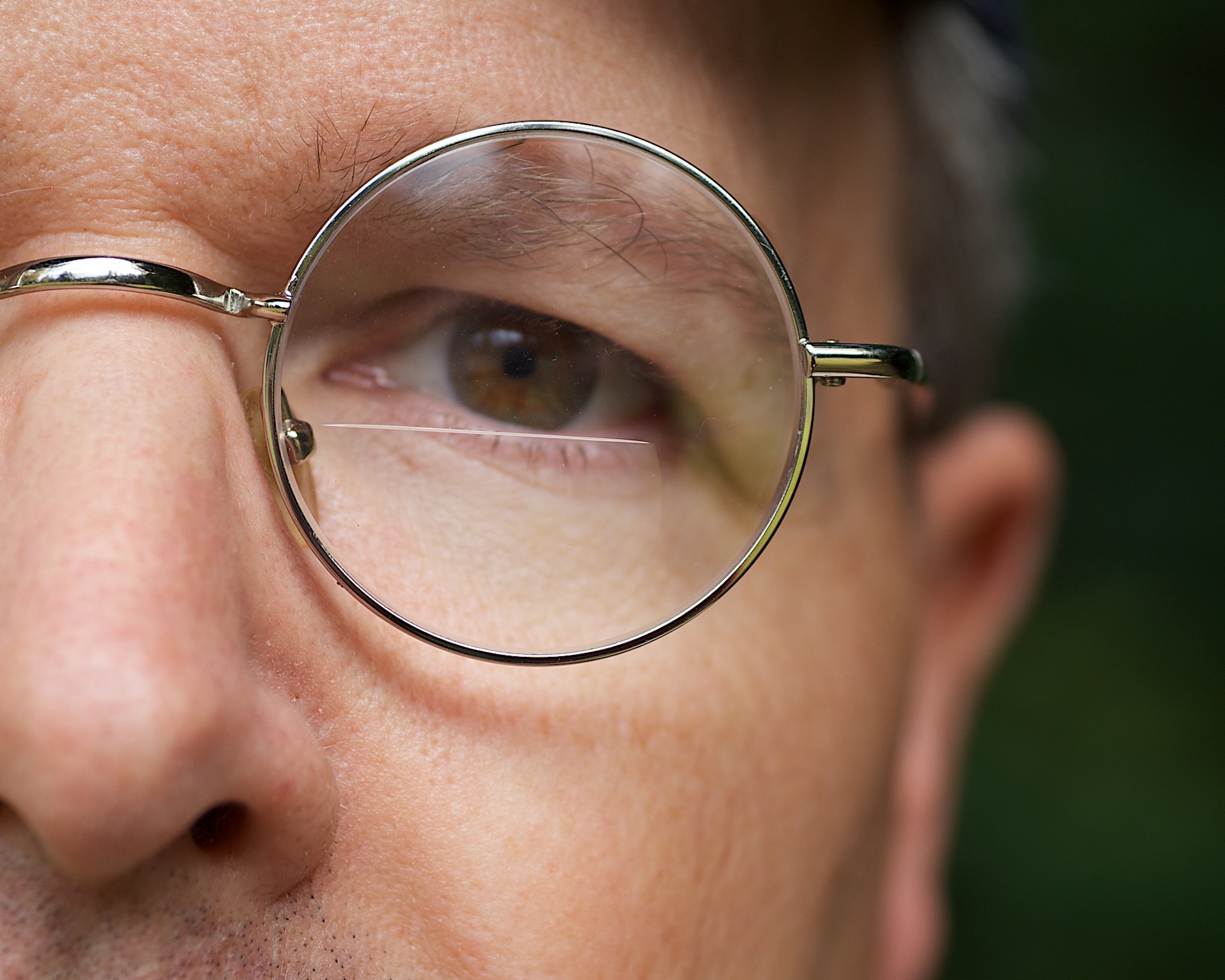

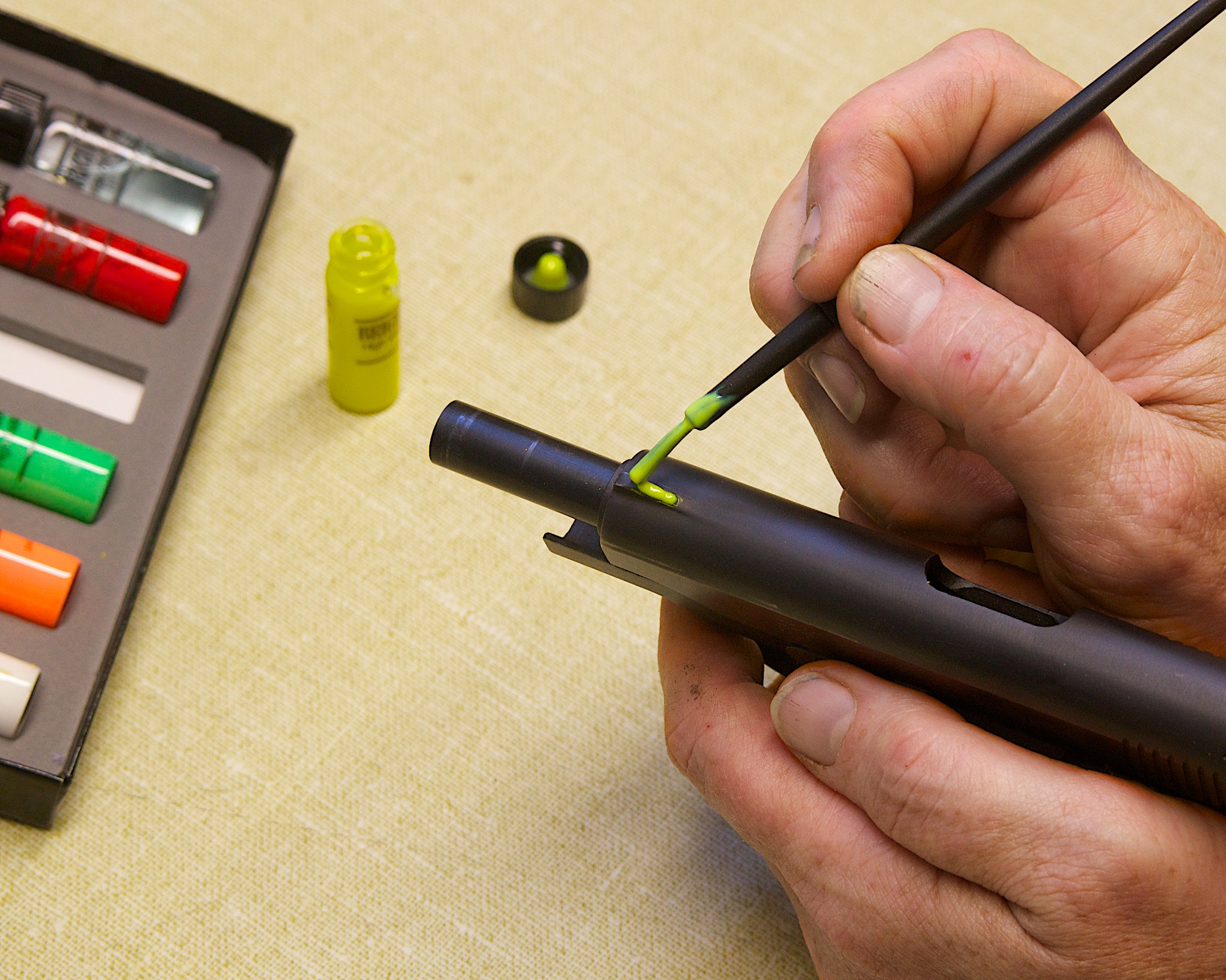
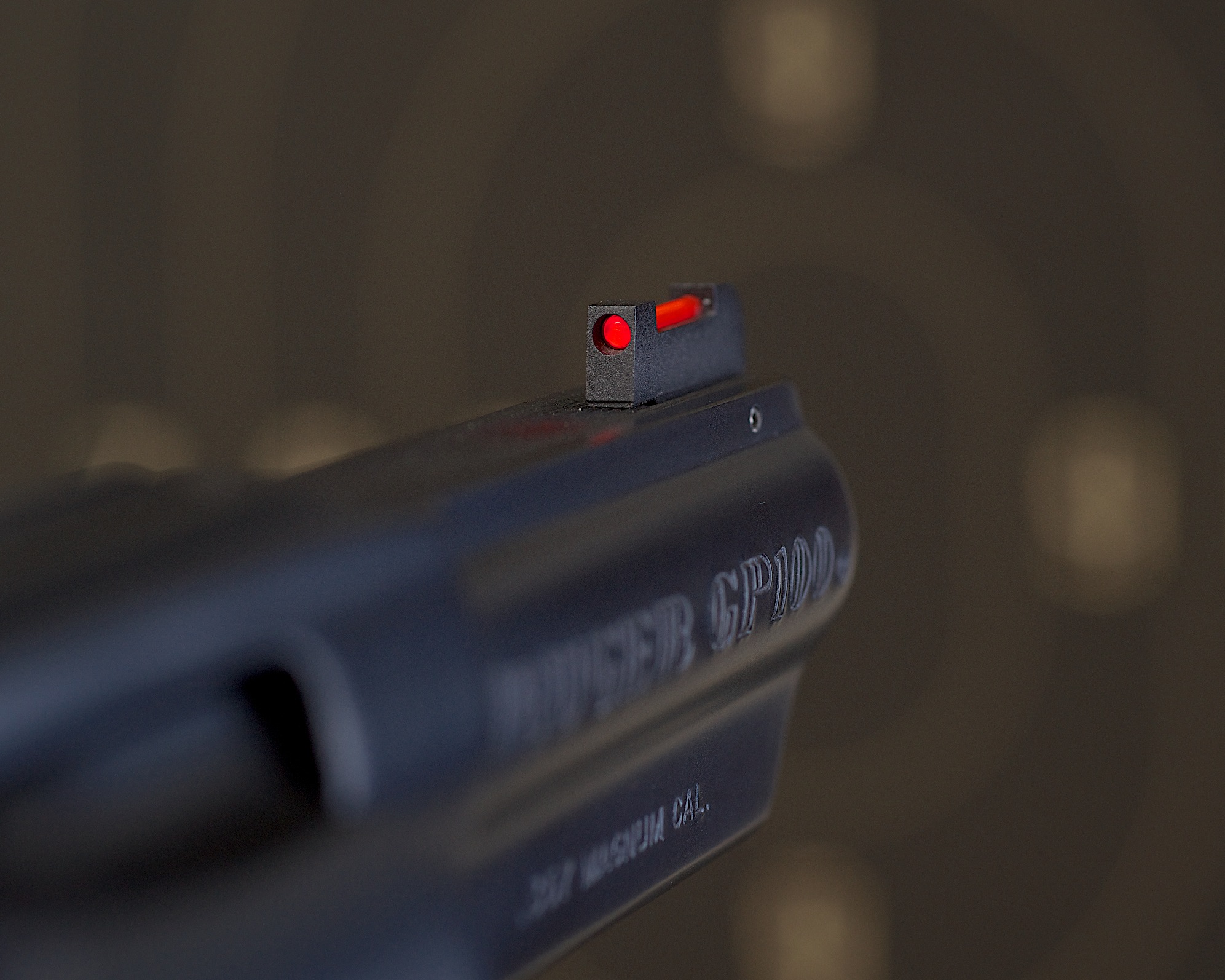
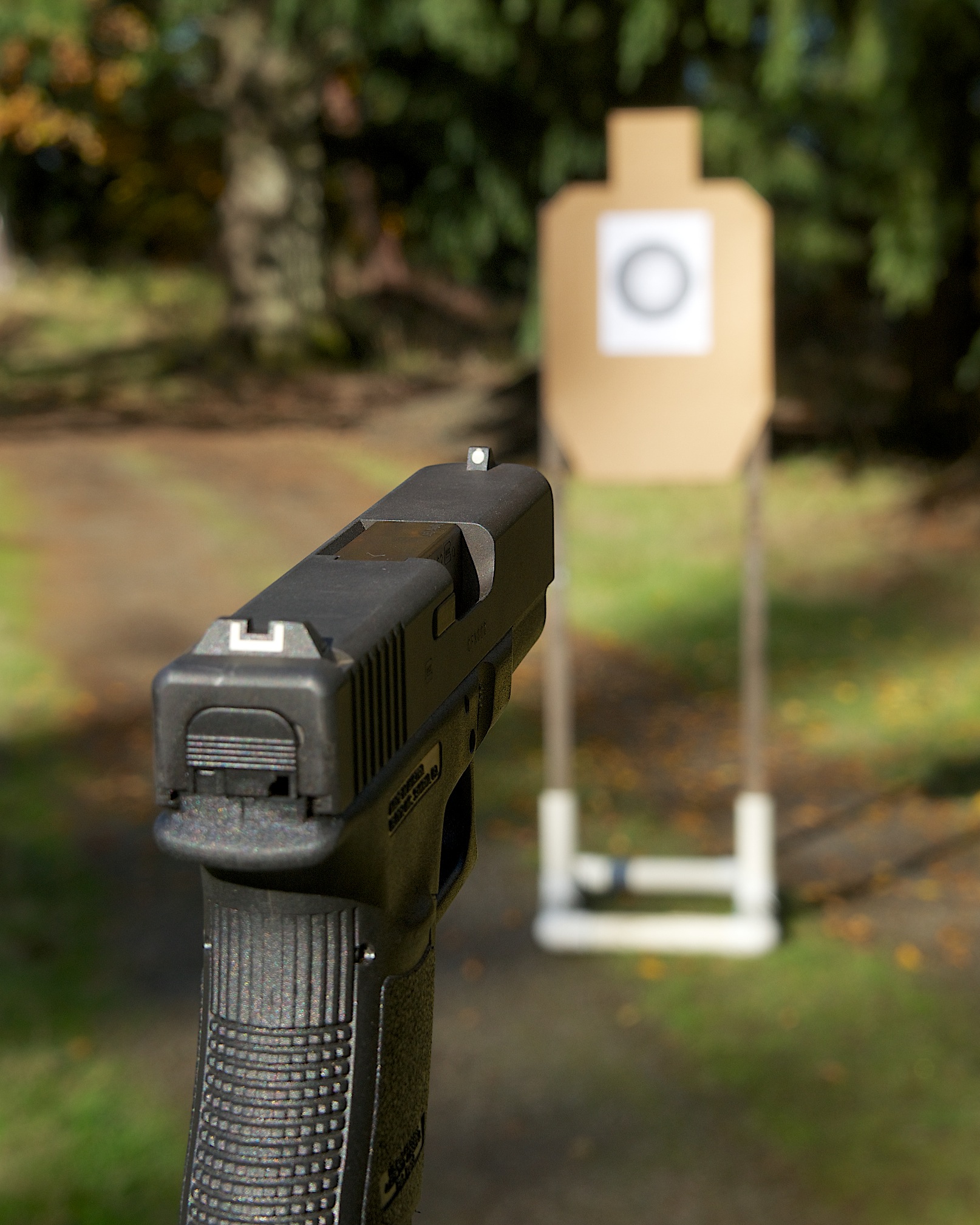
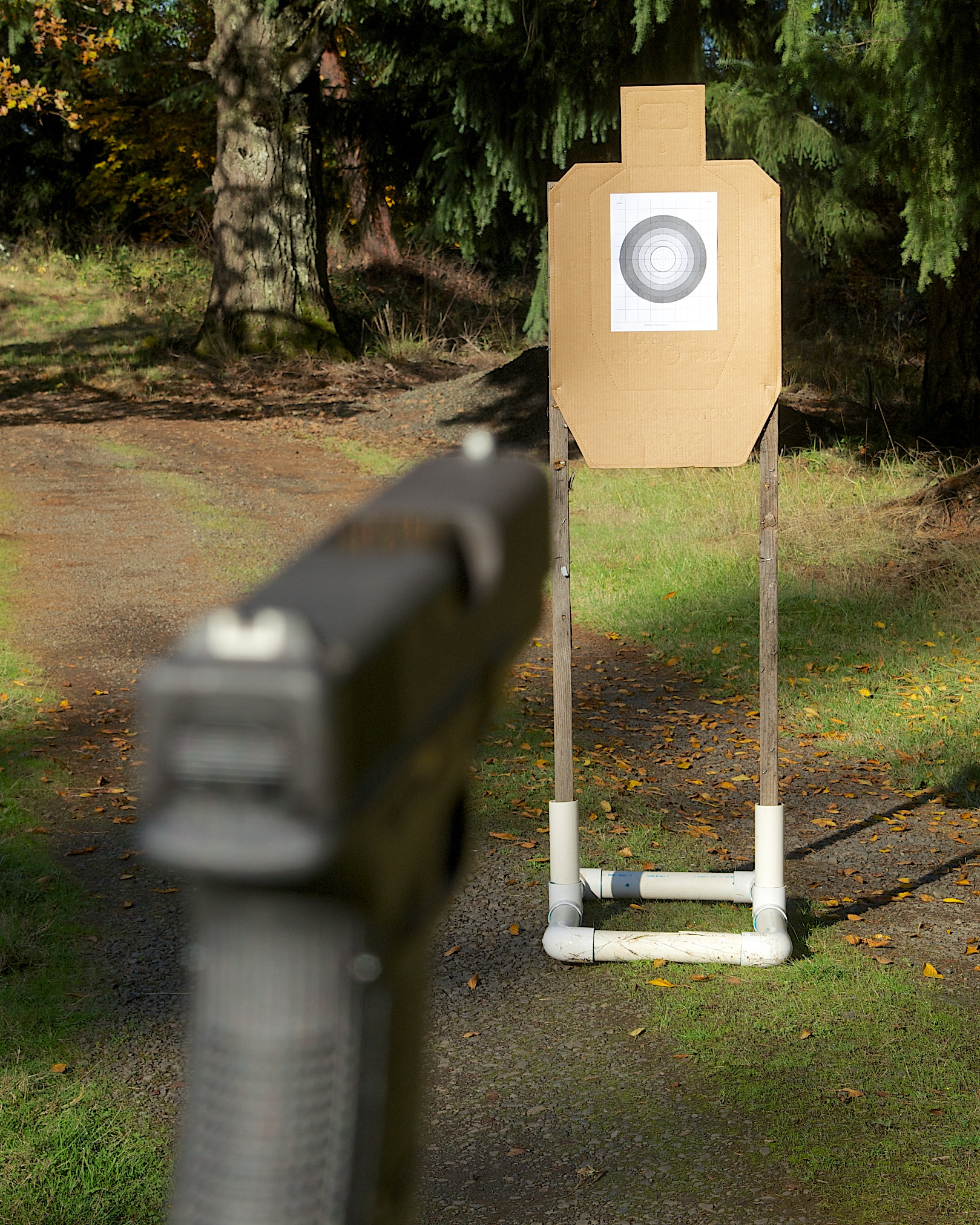
I find using a reflex sight/red dot solves the problem and it's tactically sound. You focus on the threat, not the front sight.
I put Red Dot with back up fiber optic sights. Red Dots are great because you just place the dot (1 thing) on the target. No need to line up front/rear sights (2 things), and focus is less important because you are not looking for “equal light/equal height”. You are just looking for one thing on the target. The fiber optics are great in Murphy visits.
Have been focusing on the target for years, now retired but have a qualification target from when I was working. Ten rounds .45 AC all in one ragged hole.
Hope you can help ! I’m going thru this with my eyes I’m 67.
Very good article--excellent explanations and tips.
I grew up watching cowboy movies. So when I began shooting, I felt it was important to practice different shooting stances; your typical standing and prone positions, of course. I also practice shooting from the hip. Honestly, if you're in a real firefight, you may not have an opportunity to aim as you're at target practice...
The research does not support your premise of clear the target and shoot through blurred sights. I agree that using brighter front (and different colored rear sights) will help if available. What does work is a progressive mulitfocal set a little higher than normal. The distance vision is easily accessed with a small down movement of the head, while the front sight is easily accessed with a much smaller heads up position. You have exaggerated the photo of this head's up position in your article. It is quite easy to raise the head slightly while still maintaining the body forward tactical position. Find an optometrist who is willing to do the measurements in their practice with you weapon in hand and target on the wall. Works for my patients, both civilians and law officers
This is exactly my problem. I will give this a try. Thanks!!
I have progressive lenses, and have no focus problems for the front sight or the target.
I have extreme myopia (20/2800) and was taught to shoot by LEO and security personnel when I was in my mid-20's, back in the mid-1970's. I am in my mis-60's now and have developed presbyopia. I started to teach shooting about 15 years ago, at first informally, but eventually got my NRA Certs. I never thought much about how I aimed until I went to Front Sight for their 4-day Defensive Handgun Course. They tried to get me to shoot with the Weaver stance and grip and to focus on the front sight, both of which were nigh onto impossible for me to do... and still are. I wear progressive trifocals and prefer to focus on the threat (the target) with both eyes open for defensive shooting. That way, I can identify the threat, keep track of what the threat and his buddies are doing and have periferal vision. Also, my stance is the same for rifle, shotgun and pistol, i.e., my strong side foot is always about half a step behind my off-side foot so I am slightly "bladed" with my carry side away from the threat. It keeps me better balanced than standing square to the target do recoil doesn't affect my balance and I use my off-side knee as a shock absorber for the recoil, whether shooting a handgun or a 12 ga. If I am doing precision shooting at a still target or at long distances, then I close my non-dominant eye and switch my focus between the front sight and the target while trying to steady my breathing. That stance also makes it easier to start running. 8^). I actually learned to shoot that way when we took up Cowboy Action Shooting about 15 years ago. As for Lasik surgery, the only way it will help for shooting is to get "mono-vision" where one eye is corrected for distance and the other is corrected for reading. The problem then becomes adjusting to that and the loss of depth perception. Since my vision is so bad, I have always had trouble with depth perception, so I have never even been tempted to get Lasik done, although I did do some research on it about 8 years ago. Since it is not reversible, I decided it wasn't for me. I am already practically blind and did not want to risk what little vision I have. I have taught many new shooters to focus on the target, both adults and kids. It seems to work especially well for adults. Now, thanks to this article, I understand why. BTW, if you absolutely need reading glasses for shooting, try getting a pair made with one lens corrected for your front sight's distance from your eye and the other lens plain or see if you can get a pair made with the bifocal separation done vertically instead of horizontally. That way, instead of tipping your head, you can turn it slightly and you won't mess up your balance.